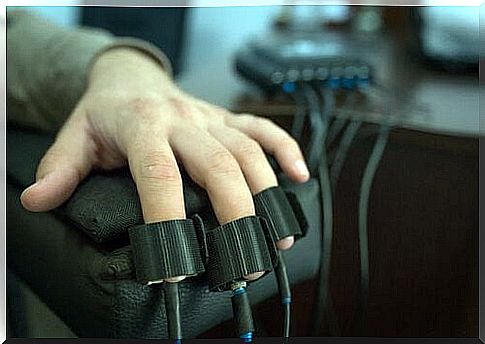Is The Polygraph Or Lie Detector Effective?

The polygraph is also known as the “lie detector.” It is an instrument designed in the twentieth century. The linguistic origin of the word polygraph comes from “poly” which means “many” and from “graphic” which refers to signs and writing.
So we can say that the polygraph is a machine that is responsible for creating characters at the same time. However, what do these signs measure? They simply determine the physiological response that the interviewee experiences.
The polygraph machine originated from the idea that emotions are expressed in the reactions of our body. For example, if I feel fear, that fear will lead to sweating, increased heart rate, and excited breathing.
The polygraph is mainly used with people who are suspected of a crime. Law officials use it to determine whether the accused is telling the truth or lying during his testimony.
A Brief History of the Polygraph
Beginning in the 1920s, people tried to design a machine that could detect deception. This is when we saw the birth of the polygraph. William Marston was responsible for the development of the project. He designed a deception curve based on various blood pressure measurements.
However, scientists did not accept the results of his lie detector as evidence. In fact, the scientific community did not approve of the polygraph as a valid procedure.
Later, Larson, a Berkeley psychiatrist and police officer, built a modified version of his predecessor’s lie detector. With this device he wanted to modernize the security services. Moreover, he wanted to avoid the brutality that the administrators sometimes used to obtain information.
Along with the blood pressure, he introduced another measurement: the respiratory rate. He added this with the intention of increasing the accuracy of the results. So, in 1924, the police began to use the polygraph in their investigations.

However, this intermediate machine had to undergo even more development to arrive at the device we use today. Keeler has added these improvements. The new measurable variable that Keeler added was the electrodermal activity.
The electrodermal activity is the extent to which our skin is able to conduct electricity. Scientists believed that doubt and by extension a lie increased the electrodermal activity of our skin. This physiological response is associated with fear or anxiety.
How does the polygraph work?
There are two tests with the polygraph that are commonly used. However, the way they work is different. However, both tests are based on formulating questions with the aim of creating certain emotional changes in the suspect. The idea is to allow the suspect to express his emotions in his physiological responses.
The Control Question Test (CQT)
This is the test most often used. The interrogator asks three different types of questions: unimportant, important, and control questions.
Unimportant Questions
These are questions that will not give us any kind of important information. They are general questions. Moreover, they have nothing to do with the research conducted by the interrogator. It is therefore expected that the interrogator does not show any kind of excitement or activation when he or she answers these questions.
Important questions
These questions are actually linked to the research. They are specific questions about the incident that happened.
We may expect that the answers are negative (after all, an affirmative answer would assume that the suspect confesses the facts). The guilty person will experience a greater level of activation (both emotional and physiological).
Control questions
These are extremely ambiguous questions. They are also very vague. The questions are meant to be impossible to answer in a negative way without doubting the answer itself. They also usually refer to very distant facts.
These questions are also unrelated to the case. However, they can refer to things the person did some time ago that are somewhat similar to the event that happened.
For example, if the crime was a murder, the interrogator might ask the interviewee if he ever hurt anyone in his life. With this question, a guilty and an innocent person will show the same level of excitement.
The interrogator looks for an innocent person to show a higher activation level during the control questions. After all, because these questions are more ambiguous, they will be afraid to make a mistake in their answer.
They answer questions that are more important to the case with less activation because they have nothing to do with the crime. However, the guilty party will show a higher activation during the important questions. This is because the body responds more to these kinds of questions than to the control questions.
The Guilty Knowledge Test
This is a test to test the knowledge of the perpetrator. It refers to the knowledge that the perpetrator possesses about the case. The interrogator asks multiple questions with multiple choice answers where only one answer is correct.
It is assumed that the perpetrator will know which choice is the right one. Thus, they will show greater excitement when the interrogator gives the correct answer. The innocent, however, knows nothing about the case. He will therefore show the same level of activation on every opportunity.
This is because they do not know which answer is the correct one because they have no knowledge of the subject. That way, the correct answer must be fully recognizable to the guilty party. However, the innocent person will not know what to choose.

The Limitations of the Polygraph
Despite the fact that we have been using the polygraph for years, we cannot deny that there are certain limitations that lower the reliability of the machine. In 2003, the National Research Council produced a report on the polygraph.
It analyzed the psychological foundations on which this instrument is based. In addition, it has also reviewed the procedures it follows. These are the researchers’ most important conclusions.
The accuracy of the polygraph
The machine thus measures the physiological reactions. However, they do not always correspond to deception. By this we mean that there is a wide variety of physiological responses that can manifest physiologically in the same way as cheating. This is a huge limitation on the accuracy for which the machine is intended.
The theoretical basis
The scientific theoretical foundations on which the polygraph is based are very weak. The terms fear and excitement are not well defined.
This is why polygraph measurements are not completely reliable when generalizing these results to other populations or groups. In short, you cannot generalize the data to other people who have not been researched.
The correctness of the evidence
The research in several studies does not match the accuracy of the tests. In this case, the consequences of determining whether or not a person is lying are very important. However, this lack of realism can lead to serious problems when it shows a higher margin of error when evaluating innocent people.
Compare data
People use the polygraph when there is no strong evidence to incriminate a suspect. So the results of the polygraph cannot be compared in any way.
Instrument manipulation
There are countermeasures that make it possible to lie to a polygraph. People have learned how to control their physiological responses. So they are able to manipulate the machine in a certain way and make sure that the results are beneficial to them.
Is the polygraph effective?
We have discussed only a few limitations here. However, the report points to many more shortcomings. From this we can deduce that the polygraph is far from completely reliable. This is very disturbing when we think about the many areas in which we use the polygraph.
The truth is that the polygraph has several flaws. This should set off an alarm. This method does not guarantee that the results are correct. So it can greatly increase the likelihood that we will convict someone who is actually innocent.









